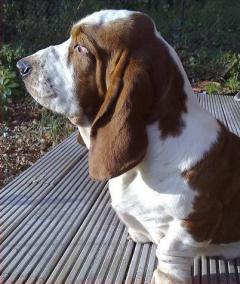Hi Everyone
Im starting off a new thread in the format of a diary. I've posted 2 previous threads on hatching a Macaw and Rheas in the incubation section which appear to be popular

https://www.backyardchickens.com/forum/viewtopic.php?id=472825
https://www.backyardchickens.com/forum/viewtopic.php?id=472294
Here in the UK our group of Dewlaps have just started to lay as the weather turns more Spring-like. Hope to post new candling pictues every few days so the thread helps to provide a visual reference for others.

Some of our Dewlap Toulouse earlier in the year.
So our Buff Dewlap female is paired to a Grey male descended from USA bloodlines. She's laying well but is only 1 year old and we're hoping for Grey Ganders that are split for Buff as there is no evidence that the male carries this gene. If he does then there is a chance of Buff goslings
 We've set 6 eggs in our Brinsea Octagon 40 forced air incubator on automatic turning. Temp is 37.4C, RH 35-40% and eggs hand turned 180 degrees once daily. I just hope there's going to be some fertile eggs or this is going to be a very short thread and I'll end up with egg on my face
We've set 6 eggs in our Brinsea Octagon 40 forced air incubator on automatic turning. Temp is 37.4C, RH 35-40% and eggs hand turned 180 degrees once daily. I just hope there's going to be some fertile eggs or this is going to be a very short thread and I'll end up with egg on my face


Candling at 0 days. A fresh Dewlap Toulouse egg with a yellow glow from the yolk.

Candling at 3.5 days. Slight shell imperfections visible but no signs of embryonic development. The yolk appears to have a more golden/deeper colour.

Candling at 4.5 days. Very early embryos are visible in 2 of the eggs. The head of the embryo is pointing towards '7pm' and early blood vessels radiating out onto the yolk at '10pm' and '4pm' positions.

Candling at 5.5 days. The embryo has grown in the last 24 hours and it is easy to see with the naked eye. They remain in the same orientation in the egg with the head towards '7pm'. The remaining 4 eggs appear infertile.

Candling at 6.5 days. There has been rapid growth of the embryo and its supporting blood vessels which are spreading out over the yolk sac. Its head continue to point to the '7pm' position.


Candling at 7.5 days. Continued growth and eye now visible. The picture from a side view shows the vessel development is confined to over the yolk. Soon the chorio-allantoic membrane will grow from the embryo's navel as a 'ballon' membrane that is well supplied with additional blood vessels. Turning the egg ensures even growth of this 'balloon' over the entire inner surface of the egg. This is the embryo's placenta which permits gas and water molecule exchange. The vessels over the yolk sac serve to deliver nutrients. So there is two distinct vascular blood systems each with its own function.

Candling at 8.5 days. The embryo continues to grow rapidly and the blood vessels have spread out over the entire upper surface of the yolk sac.


Candling at 9.5 days. Now the detail is not so clear as the allantoic membrance lines the upper two thirds of the shell. This is starting to perform its function of gas and water molecule exchange to meet the growing demands of the embryo. The picture from the side shows this membrane now covers over half the inner surface of the shell.

Candling at 10.5 days. The detail inside the egg is becoming more difficult to see as growth continues. The embryo is now located towards the sharp end of the egg.

Candling at 11.5 days. The egg is gradually becoming darker as more of the details are obscured.

Candling at 13.5 days. The eggs are becoming progressively darker making any detail difficult to see. The air cell is continuing to enlarge.

Candling at 17.5 days. The chick moves vigourously during candling and the vessels of the allantoic membrane are now very large and completely line the inner egg-shell. The eggs both appear to be developing well but I believe they're not losing sufficent moisture!

Candling at 19.5 days. The eggs continue to darken and it's difficult to see detail except the mass of the gosling and yolk. The air cell should be larger but it has extended further down the egg by approx' 2mm. I've been marking its outline with a pencil and hope this can be seen in the picture above.

Candling at 21.5 days. The goslings are now almost filling the egg and only the vessels near the air cell line can be seen. The air cell has enlarged by approx 2mm again but should still be bigger at 21 days. Unless I can achieve a greater moisture loss these goslings may die before internal pipping!

Candling at 23.5 days. Both eggs developing and occassional movement seen on candling. The goslings are now occupying almost all of the egg and detail only visible just below the air cell. The air cell continues to enlarge and increasing at about 2mm every 2 days. I dont anticipate internal pipping before day 26/27 so Im hoping it will enlarge at least another 3mm before then.


Candling at 25.5 days. As the goslings fill the egg there is very little detail to see. The air cells have increased a further 3mm on both eggs and appear 'reasonable' but would prefer a little bigger. Incubating at 37.2C, RH25%, daily cooling and light mist, air vents open to maximum. The air cells angle down one side and have been turned with the side showing the greatest amount of air cell uppermost. Turning has now stopped. Pics show both the eggs, the left showing candling and the right showing air cell development.


Candling at 26.5 days and Air Cell Development. The goslings now fill the eggs and there has been a further 2mm increase in air cell size. The upper surface of the egg has been marked with a straight line to show the correct position for hatching. There are tiny 2mm shadows moving at the back side of the air cell.


Candling at 27.5 days and Air Cell Development. The air cells have enlarged a little more and a small faint shadowing can be seen at the back of the air cell. The eggs are beginning to 'twitch' when observed. No internal pipping yet but Im now happy with air cell size. Weight loss 15%.


Candling at 28.5 days, Front and Side Views. The air cells have enlarged and shadowing is visible in the air cell though not as expected!


Air Cell Size of Eggs at 28.5 days.


The reason for the unusual air cell shape and shadows became clear, both eggs have externally pipped but in the narrow end of the egg! Both are making a regular clicking sound which is their lung respiration. They are also faintly peeping.

Day 28.5. Both eggs are transferred to the hatcher for 'Lockdown'. Temp 37.2C and Relative Humidity 70%.
Well I came home from work this evening to a very welcome sight
 You've all followed this egg's progress for almost a month since a tiny heartbeat in the egg. We're thrilled to welcome our latest addition - WALDO!
You've all followed this egg's progress for almost a month since a tiny heartbeat in the egg. We're thrilled to welcome our latest addition - WALDO!


Day 29.5. The 1st egg has hatched!!! The gosling managed to rotate and hatch unassisted 24 hours after External Pipping. The 2nd egg is still breathing and peeping. We may choose to assist if no progress is made in the next 12 hours. However the gosling has enlarged its external pip hole.




Day 30. With no progress 36 hours after external pipping I decided to assist. The egg was candled and showed no evidence of active blood vessels and the gosling appeared trapped in an oblique position. Using a Q-tip moistened in boiled cooled water the area around the pip was probed and membrane moistened. With no blood vessels visible the membrane was opened up. At this point I could see inside the shell with a candler and confirmed yolk sac absorption. The gosling's beak was held gently though firmly and the head eased through the opening. Visibly exhausted the gosling rested and was left to warm in the incubator. After an hour the gosling became active and proceeded to kick and squeeze itself free from the shell.








HELLO GOSLINGS!!! 18 hours after the 2nd gosling hatched they are both fluffed up and transferred to our rearing box under an infra-red lamp. The goslings are walking (though a little wobbly) have drunk well and are beginning to pick at Starter Crumbs. They are housed on non slip mats which are washed daily and reduce incidence of slayed legs. They're both active and progressing very well. The 2nd gosling to hatch has a bigger beak and body but is also lighter in colour. We think its a boy and girl. The boy will carry the Buff colour gene from his mother.
Thats all for now folks

A very happy and releived Pete



Im starting off a new thread in the format of a diary. I've posted 2 previous threads on hatching a Macaw and Rheas in the incubation section which appear to be popular

https://www.backyardchickens.com/forum/viewtopic.php?id=472825
https://www.backyardchickens.com/forum/viewtopic.php?id=472294
Here in the UK our group of Dewlaps have just started to lay as the weather turns more Spring-like. Hope to post new candling pictues every few days so the thread helps to provide a visual reference for others.
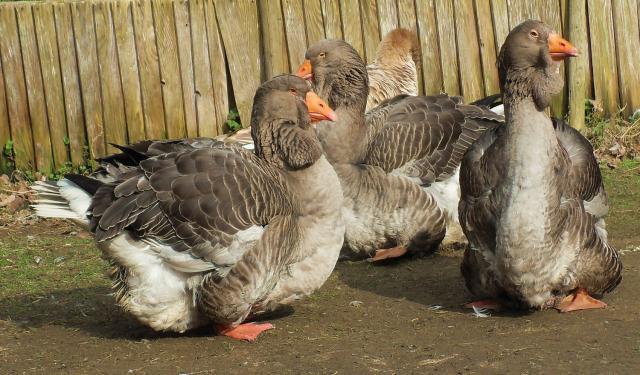
Some of our Dewlap Toulouse earlier in the year.
So our Buff Dewlap female is paired to a Grey male descended from USA bloodlines. She's laying well but is only 1 year old and we're hoping for Grey Ganders that are split for Buff as there is no evidence that the male carries this gene. If he does then there is a chance of Buff goslings


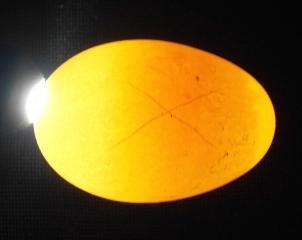
Candling at 0 days. A fresh Dewlap Toulouse egg with a yellow glow from the yolk.
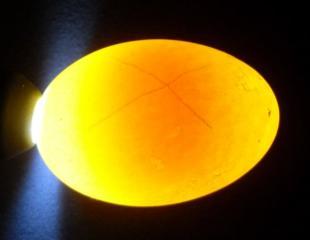
Candling at 3.5 days. Slight shell imperfections visible but no signs of embryonic development. The yolk appears to have a more golden/deeper colour.
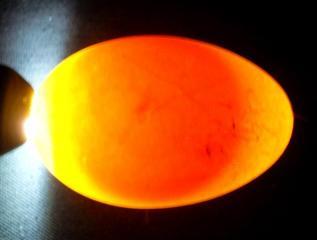
Candling at 4.5 days. Very early embryos are visible in 2 of the eggs. The head of the embryo is pointing towards '7pm' and early blood vessels radiating out onto the yolk at '10pm' and '4pm' positions.
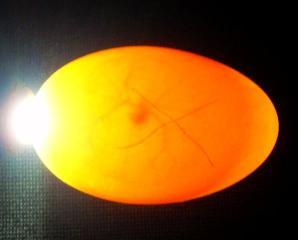
Candling at 5.5 days. The embryo has grown in the last 24 hours and it is easy to see with the naked eye. They remain in the same orientation in the egg with the head towards '7pm'. The remaining 4 eggs appear infertile.
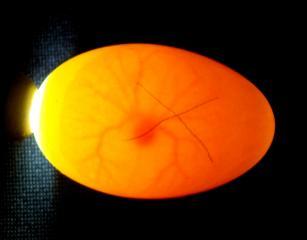
Candling at 6.5 days. There has been rapid growth of the embryo and its supporting blood vessels which are spreading out over the yolk sac. Its head continue to point to the '7pm' position.
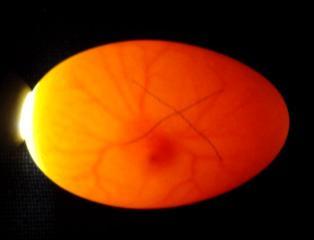
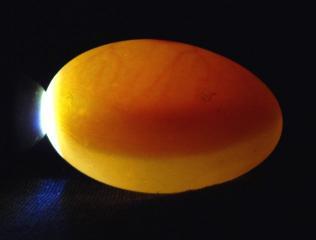
Candling at 7.5 days. Continued growth and eye now visible. The picture from a side view shows the vessel development is confined to over the yolk. Soon the chorio-allantoic membrane will grow from the embryo's navel as a 'ballon' membrane that is well supplied with additional blood vessels. Turning the egg ensures even growth of this 'balloon' over the entire inner surface of the egg. This is the embryo's placenta which permits gas and water molecule exchange. The vessels over the yolk sac serve to deliver nutrients. So there is two distinct vascular blood systems each with its own function.
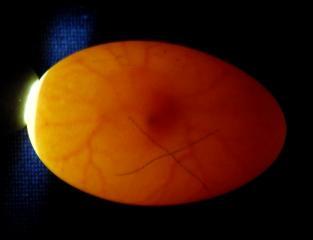
Candling at 8.5 days. The embryo continues to grow rapidly and the blood vessels have spread out over the entire upper surface of the yolk sac.
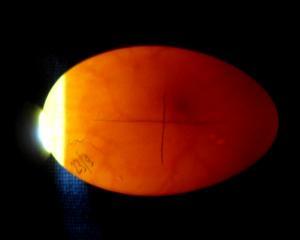
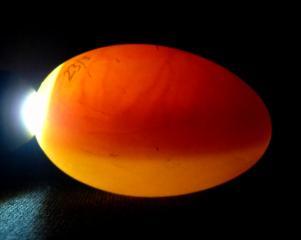
Candling at 9.5 days. Now the detail is not so clear as the allantoic membrance lines the upper two thirds of the shell. This is starting to perform its function of gas and water molecule exchange to meet the growing demands of the embryo. The picture from the side shows this membrane now covers over half the inner surface of the shell.
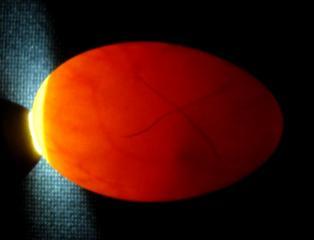
Candling at 10.5 days. The detail inside the egg is becoming more difficult to see as growth continues. The embryo is now located towards the sharp end of the egg.
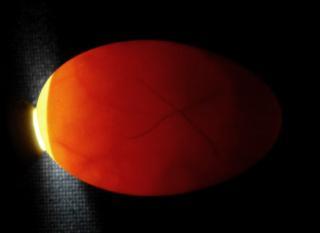
Candling at 11.5 days. The egg is gradually becoming darker as more of the details are obscured.
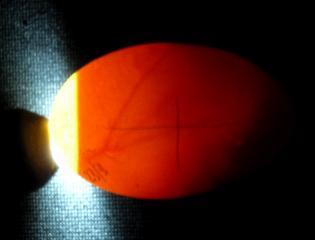
Candling at 13.5 days. The eggs are becoming progressively darker making any detail difficult to see. The air cell is continuing to enlarge.
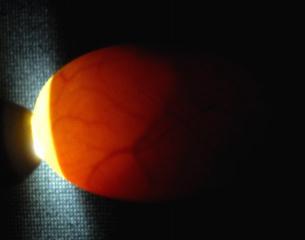
Candling at 17.5 days. The chick moves vigourously during candling and the vessels of the allantoic membrane are now very large and completely line the inner egg-shell. The eggs both appear to be developing well but I believe they're not losing sufficent moisture!
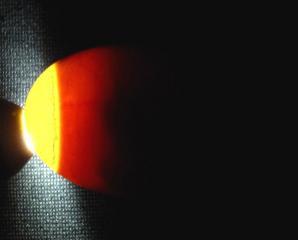
Candling at 19.5 days. The eggs continue to darken and it's difficult to see detail except the mass of the gosling and yolk. The air cell should be larger but it has extended further down the egg by approx' 2mm. I've been marking its outline with a pencil and hope this can be seen in the picture above.
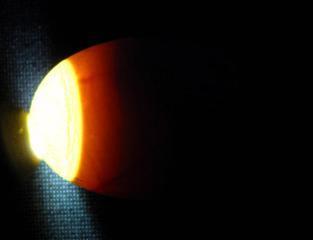
Candling at 21.5 days. The goslings are now almost filling the egg and only the vessels near the air cell line can be seen. The air cell has enlarged by approx 2mm again but should still be bigger at 21 days. Unless I can achieve a greater moisture loss these goslings may die before internal pipping!
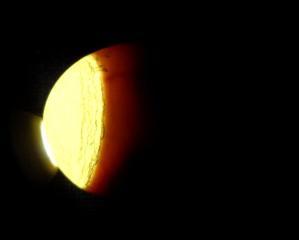
Candling at 23.5 days. Both eggs developing and occassional movement seen on candling. The goslings are now occupying almost all of the egg and detail only visible just below the air cell. The air cell continues to enlarge and increasing at about 2mm every 2 days. I dont anticipate internal pipping before day 26/27 so Im hoping it will enlarge at least another 3mm before then.
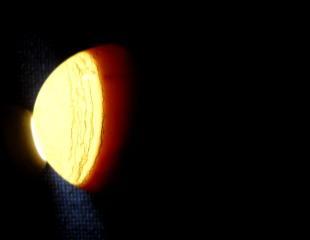
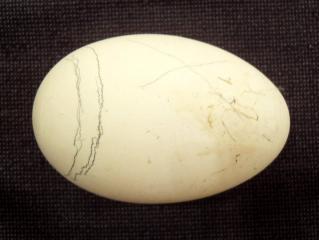
Candling at 25.5 days. As the goslings fill the egg there is very little detail to see. The air cells have increased a further 3mm on both eggs and appear 'reasonable' but would prefer a little bigger. Incubating at 37.2C, RH25%, daily cooling and light mist, air vents open to maximum. The air cells angle down one side and have been turned with the side showing the greatest amount of air cell uppermost. Turning has now stopped. Pics show both the eggs, the left showing candling and the right showing air cell development.
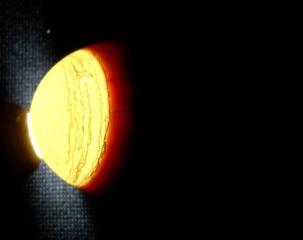
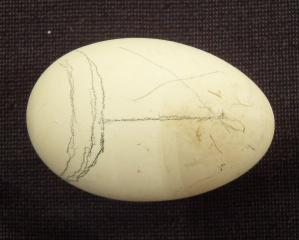
Candling at 26.5 days and Air Cell Development. The goslings now fill the eggs and there has been a further 2mm increase in air cell size. The upper surface of the egg has been marked with a straight line to show the correct position for hatching. There are tiny 2mm shadows moving at the back side of the air cell.
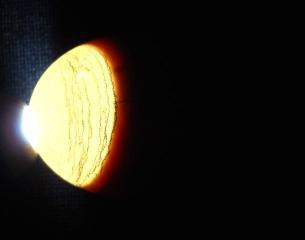
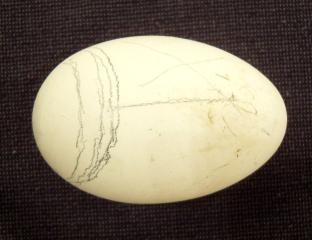
Candling at 27.5 days and Air Cell Development. The air cells have enlarged a little more and a small faint shadowing can be seen at the back of the air cell. The eggs are beginning to 'twitch' when observed. No internal pipping yet but Im now happy with air cell size. Weight loss 15%.
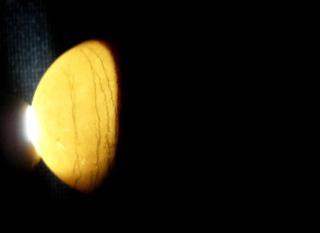
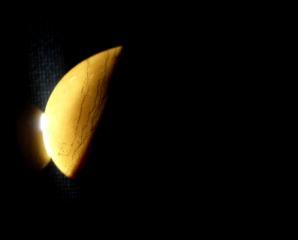
Candling at 28.5 days, Front and Side Views. The air cells have enlarged and shadowing is visible in the air cell though not as expected!
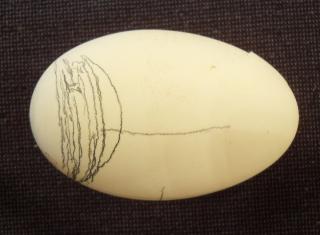
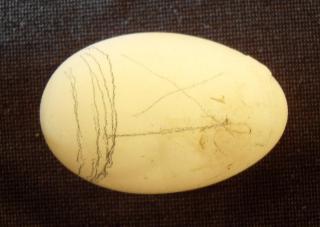
Air Cell Size of Eggs at 28.5 days.
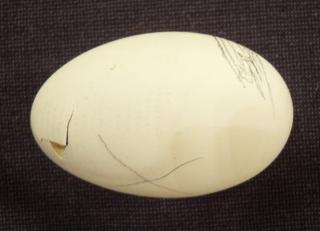
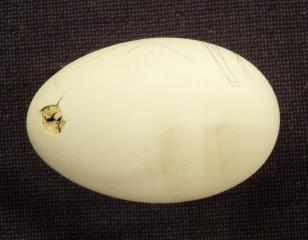
The reason for the unusual air cell shape and shadows became clear, both eggs have externally pipped but in the narrow end of the egg! Both are making a regular clicking sound which is their lung respiration. They are also faintly peeping.
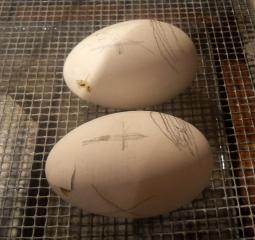
Day 28.5. Both eggs are transferred to the hatcher for 'Lockdown'. Temp 37.2C and Relative Humidity 70%.
Well I came home from work this evening to a very welcome sight


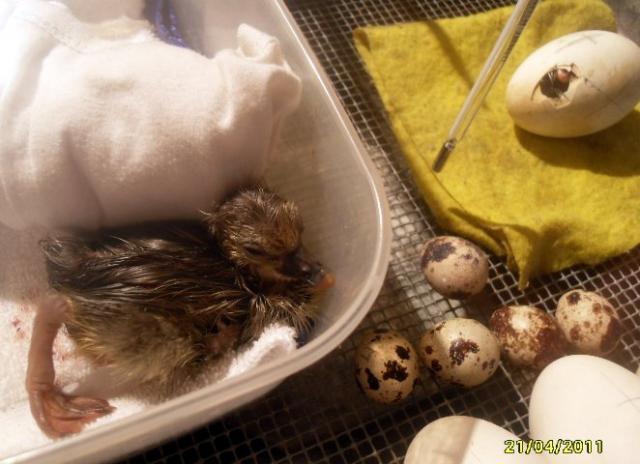
Day 29.5. The 1st egg has hatched!!! The gosling managed to rotate and hatch unassisted 24 hours after External Pipping. The 2nd egg is still breathing and peeping. We may choose to assist if no progress is made in the next 12 hours. However the gosling has enlarged its external pip hole.
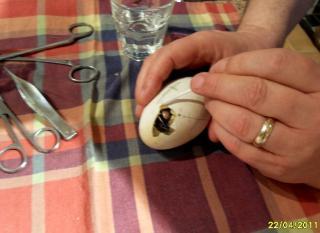
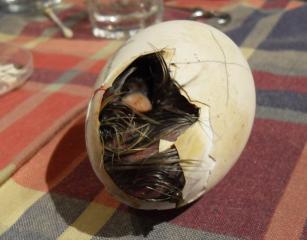

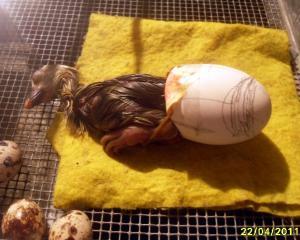
Day 30. With no progress 36 hours after external pipping I decided to assist. The egg was candled and showed no evidence of active blood vessels and the gosling appeared trapped in an oblique position. Using a Q-tip moistened in boiled cooled water the area around the pip was probed and membrane moistened. With no blood vessels visible the membrane was opened up. At this point I could see inside the shell with a candler and confirmed yolk sac absorption. The gosling's beak was held gently though firmly and the head eased through the opening. Visibly exhausted the gosling rested and was left to warm in the incubator. After an hour the gosling became active and proceeded to kick and squeeze itself free from the shell.







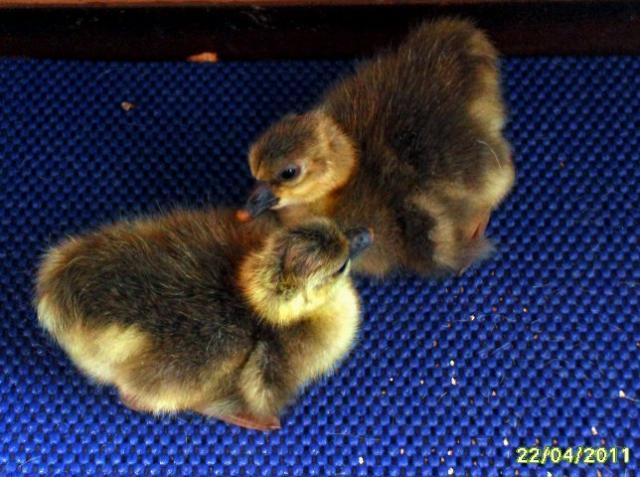
HELLO GOSLINGS!!! 18 hours after the 2nd gosling hatched they are both fluffed up and transferred to our rearing box under an infra-red lamp. The goslings are walking (though a little wobbly) have drunk well and are beginning to pick at Starter Crumbs. They are housed on non slip mats which are washed daily and reduce incidence of slayed legs. They're both active and progressing very well. The 2nd gosling to hatch has a bigger beak and body but is also lighter in colour. We think its a boy and girl. The boy will carry the Buff colour gene from his mother.
Thats all for now folks

A very happy and releived Pete



Last edited:


